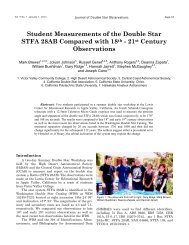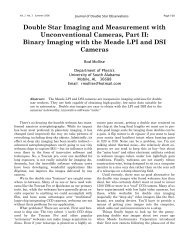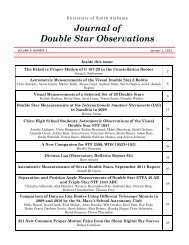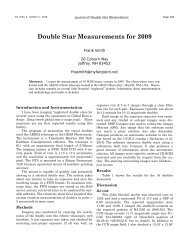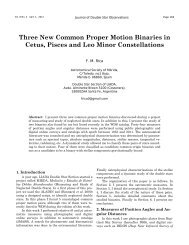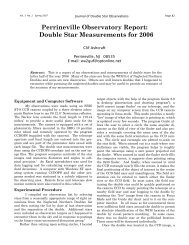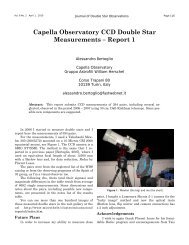Lucky Imaging Astrometry of 59 Andromedae - JDSO.org
Lucky Imaging Astrometry of 59 Andromedae - JDSO.org
Lucky Imaging Astrometry of 59 Andromedae - JDSO.org
You also want an ePaper? Increase the reach of your titles
YUMPU automatically turns print PDFs into web optimized ePapers that Google loves.
Vol. 9 No. 3 July 1, 2013 Journal <strong>of</strong> Double Star ObservationsPage 196<strong>Lucky</strong> <strong>Imaging</strong> <strong>Astrometry</strong> <strong>of</strong> <strong>59</strong> <strong>Andromedae</strong>propriate for observation without supplemental magnification.Three sets <strong>of</strong> observations were made as detailedbelow: (1) drifts to determine the camera’s anglewith respect to north, (2) observations <strong>of</strong> two standarddouble stars to determine both the camera’s orientationand pixel plate scale, and (3) observations <strong>of</strong> <strong>59</strong> <strong>Andromedae</strong>itself.<strong>Lucky</strong> <strong>Imaging</strong>The atmosphere is composed <strong>of</strong> many small aircells <strong>of</strong> slightly different temperature and density (Fried1966, Tatarski 1961). Each cell is typically about eightinches across. The cells deflect the path <strong>of</strong> starlight asthey move across the telescope’s field-<strong>of</strong>-view, causingthe rapid movement <strong>of</strong> stars (jitter) which blurs thestar’s image during normal exposures. This degradingeffect <strong>of</strong> “seeing” can be reduced by locating telescopeson high altitude mountaintops.For a very small area <strong>of</strong> the sky, about 10 arc secondsin diameter, known as an “isoplanatic patch,” theeffects <strong>of</strong> poor seeing can be greatly reduced throughlucky imaging or speckle interferometry (Law 2006).Within the isoplanatic patch, the jitter motion <strong>of</strong> stars iscorrelated—i.e. stars move together. By taking veryshort exposures (10 to 30 milli-seconds) it is possible toessentially “freeze” the images and thus remove the tiptiltportion <strong>of</strong> the atmospheric blurring (seeing) effects(Anton 2012).Even then, most images are still blurry. Fortunately,a small percentage can be quite clear. However,due to the short exposures, these few clear exposuresare also faint. <strong>Lucky</strong> imaging simply takes many shortexposures, saves the best ones, and discards the rest <strong>of</strong>them. Since the small percentage <strong>of</strong> clear exposuresstill “bounce” around from one exposure to the nextdue to atmospheric jitter, they have to be individuallyaligned. Once aligned, the images can then be“stacked,” essentially adding all the clear images togetherto form a final, brighter and higher signal/noiseratio, single image. The selection <strong>of</strong> the clearest images(from hundreds or even thousands) and aligningand stacking these images has been automated.Equipment and S<strong>of</strong>twareAt the Orion Observatory, a 10-inch, f/10 Schmidt-Cassegrain telescope, made by Meade and equippedwith a Sidereal Technology control system, was used tomake the observations. An 80 mm guide scope,equipped with a Santa Barbara Instruments Group(SBIG) ST-402 CCD camera, provided field identificationand initial centering.A high-speed Andor Luca-S electron multiplyingCCD camera was used (unfiltered and without any Barlowlens) for lucky imaging astrometry. This camera’shigh speed is achieved, in part, through a s<strong>of</strong>twareselectableRegion <strong>of</strong> Interest (RoI), allowing just asmall portion <strong>of</strong> the overall pixel array to be read out.Normally, reading out a CCD camera at high speedis much noisier than at slow speeds due to the inherentnature <strong>of</strong> analog-to-digital (A/D) converters. However,by adding a special row <strong>of</strong> pixels to the chip just beforethe A/D converter, with each pixel in this row being ata slightly higher voltage level than its predecessor, theelectron charges corresponding to the observed lightlevels can be multiplied by a factor <strong>of</strong> up to 1000 asthey are clocked through this electron multiplying row.Although this amplification in itself introduces somenoise, for high speeds and low light levels this addednoise is small compared to the high speed read noise <strong>of</strong>the A/D converter and, as a result, the overall noise isgreatly reduced from what it would have been withoutelectron multiplication (EM).Finally, it might be noted that although EM cangreatly reduce overall noise at high speeds, at the slowreadout speeds <strong>of</strong> many CCD applications the readnoise is comparatively low and EM can actually increaseoverall noise. The Andor Luca-S camera hastwo different selectable outputs—one with and onewithout EM, allowing the camera to be used in a modeFigure 2: Sophia Bylsma, Anna Zhang, and Everett Heath at theOrion Observatory. The Andor Luca-S high-speed emCCD cameracan be seen just below the telescope.
Vol. 9 No. 3 July 1, 2013 Journal <strong>of</strong> Double Star ObservationsPage 198<strong>Lucky</strong> <strong>Imaging</strong> <strong>Astrometry</strong> <strong>of</strong> <strong>59</strong> <strong>Andromedae</strong>Table 2. Separation, position angle, and difference in magnitudemeasurements for <strong>59</strong> <strong>Andromedae</strong> with the averages,standard deviations, and standard errors <strong>of</strong> the mean.BesselianEpochFramesSep.(arc sec)PA (°) dMagB2012.865 000-499 16.156 36.18 1.08B2012.865 500-999 16.136 36.44 1.10B2012.865 1000-1499 16.167 36.38 1.07B2012.865 1500-1<strong>59</strong>9 16.209 36.27 1.06B2012.865 2000-2499 16.149 36.40 1.07Average 16.160 36.33 1.08St. Dev. 0.03 0.11 0.02St. Err. Mean 0.01 0.05 0.01eted with calibration observations we could have developedconfidence in the constancy <strong>of</strong> the camera’s orientationand pixel plate scale.Program ObservationsAltogether 2500 frames (images) were recordedfor <strong>59</strong> <strong>Andromedae</strong>. Similar to the calibrationdoubles, we split the data into sets <strong>of</strong> 500 frames each,applied REDUC’s “best <strong>of</strong> max” brightest pixel sortingto each <strong>of</strong> the five sets, saved the best 10% (50 framesfrom each set), and aligned and stacked these images.Assuming the camera angle and plate scale providedfrom our observations <strong>of</strong> the calibration pair STT 547,we obtained the program results shown in Table 2.It is instructive to compare, for the same total integrationtime, what the image looks like with and withoutlucky imaging. Figure 3, left, shows the image thatresults from stacking all 500 frames <strong>of</strong> the first setwithout any selection or alignment—the “raw” image.The image on the right is <strong>of</strong> the best 50 <strong>of</strong> the 500frames shown after both alignment and stacking—thelucky image. The lucky image is much more sharplydefined (higher resolution) and, as a result, providesastrometry <strong>of</strong> significantly higher precision.These two images clearly demonstrate howwell lucky imaging can overcome atmospheric distortions(not to mention poor tracking). Because the centroids<strong>of</strong> the individual stars can be more precisely determinedwith lucky imaging, it follows that the positionangle and separation will also be more precise.Furthermore, if the separation <strong>of</strong> the two stars had beenso close that the raw image stars were merging togetherinto a single image, the stars in the lucky image couldstill have been resolvable and usable. Thus lucky imagingnot only allows higher precision, but also closerdoubles to be measured.Comparison with Previous ObservationsWilliam Herschel, in 1783, was the first astronomerto report the separation and position angle <strong>of</strong> the <strong>59</strong><strong>Andromedae</strong> pair (Smyth 1844). John Herschel andJames South observed this double in 1822 (South andHerschel 1824). Friedrich von Struve, for whom theSTF designation was given, observed <strong>59</strong> <strong>Andromedae</strong>twice, in 1822 and 1831 (Struve 1837). Recently, DavidArnold visually observed the pair in 2005 (ArnoldFigure 3: Left is the first 500 images just stacked. Right is the best 10% <strong>of</strong> the first 500 images (i.e. 50images) stacked and aligned.
Vol. 9 No. 3 July 1, 2013 Journal <strong>of</strong> Double Star ObservationsPage 199<strong>Lucky</strong> <strong>Imaging</strong> <strong>Astrometry</strong> <strong>of</strong> <strong>59</strong> <strong>Andromedae</strong>2006). Mason, et al. used speckle interferometry tomeasure this double in 2006, 2007, 2008, and 2011(Mason, et al. 2007, 2008, and 2010, and Mason andHartkopf 2013). A total <strong>of</strong> 83 measurements <strong>of</strong> separationand 85 <strong>of</strong> position angle have been made since1783.This double does not have an ephemeris in eitherthe Sixth Orbit Catalog or the Catalog <strong>of</strong> RectilinearElements. To consider, roughly, the accuracy <strong>of</strong> ourmeasured separation and position angle, an average <strong>of</strong>observations over the last 25 years was used as a comparison.The past observations were supplied by BrianMason at the US Naval Observatory. The averageseparation <strong>of</strong> the past 25 years is 16.68” while our observedseparation in the present study was 16.16”, a0.52” difference. The average position angle <strong>of</strong> the past25 years is 35.60° while our observed position angle inthe present study was 36.33°, a 0.73° difference.Another way <strong>of</strong> considering comparisons with previousobservations is viewing visual plots. Ed Wileykindly plotted our data using a spreadsheet developedby Francisco Rica Romero. The observations were correctedfor precession and proper motion prior to plottingand converted to Cartesian coordinates. X and Yplots versus epoch are shown in Figures 4 and 5, whileFigure 6 is a cluster plot <strong>of</strong> the X/Y positions withoutSTF222 X versus Epoch13121110X98761750 1800 1850 1900 1950 2000 2050Epoch1783‐20112012.865Figure 4: X values versus epoch. Open circles are previous observations, while the filledsquare is our observationSTF 222 Y versus Epoch17161514Y131211101750 1800 1850 1900 1950 2000 2050Epoch1783‐20112012.865Figure 5: Y values versus epoch.
Vol. 9 No. 3 July 1, 2013 Journal <strong>of</strong> Double Star ObservationsPage 200<strong>Lucky</strong> <strong>Imaging</strong> <strong>Astrometry</strong> <strong>of</strong> <strong>59</strong> <strong>Andromedae</strong>STF222 Cluster Plot18.016.014.012.010.0Y8.06.04.02.00.00.0 5.0 10.0 15.0X1783‐20112012.865Figure 6: Cluster plot <strong>of</strong> X and Y positions plotted as a cluster without epoch information.The result is a fairly tight cluster. Our observation is not an outlier.respect to epoch.Is <strong>59</strong> <strong>Andromedae</strong> an Optical Double or a Binary?All nine measurements from the first 50 years <strong>of</strong>observation, beginning in 1822, were averaged to determinehow the pair has changed over time. The averageseparation <strong>of</strong> the first 50 years, as show in Table 3 is16.53”, a 0.15” difference from the average over thelast 25 years. The average position angle <strong>of</strong> the first 50years is 34.89°, a 0.71° difference from the last 25years. Both differences are within a single standarddeviation and are therefore insignificant.The spectral type <strong>of</strong> <strong>59</strong> <strong>Andromedae</strong>’s primarycomponent (SAO 55330) is B9V and its magnitude is6.05 (SIMBAD 2012). The spectral type <strong>of</strong> the secondarycomponent (SAO 55331) is A1V and its magnitudeis 6.71 (SIMBAD 2012). The B9 and A1 starsprobably have a similar brightness because they areeach just one tenth <strong>of</strong> a “class” away from A0. Sincetheir spectral types are so similar and both are on themain sequence, the stars could be roughly the same distancefrom Earth.On the other hand, SAO 55330 has a parallax <strong>of</strong>0.01241” ± 0.00283” which corresponds to a distance<strong>of</strong> 263 light years (SIMBAD 2012). SAO 55331 has aparallax <strong>of</strong> 0.00192” ± 0.01175” which yields a distance<strong>of</strong> 1699 light years (SIMBAD 2012). However,the error for the secondary star's distance is sizable,ranging from 236 light years to infinity (SIMBAD2012). Thus, based on parallaxes, it is possible, thoughunlikely, that the two stars are at the same distancefrom Earth. If both stars were 263 light years fromearth (and the average separation <strong>of</strong> the past 25 years <strong>of</strong>16.68” is correct), they would be ~1.22 light years(77,154AU) apart—perhaps too far apart to be gravitationallybound, but close enough to be a commonproper motion pair.Table 3: Average separation and position angle for observations in the first 50 years and last 25 years withstandard deviations and standard errors <strong>of</strong> the mean.First 50 YearsSep (“)Last 25 YearsSep (“)Diff(“)First 50 YearsPA (°)Last 25 YearsPA (°)Diff.PA (°)Average 16.53 16.68 0.15 34.89 35.60 0.71St. Dev. 0.37 0.92 0.93 0.90St. Err. Mean 0.07 0.17 0.17 0.17
Vol. 9 No. 3 July 1, 2013 Journal <strong>of</strong> Double Star ObservationsPage 201<strong>Lucky</strong> <strong>Imaging</strong> <strong>Astrometry</strong> <strong>of</strong> <strong>59</strong> <strong>Andromedae</strong>Finally, double stars are most likely binary if theproper motion vectors <strong>of</strong> the two stars are similar. Theproper motion (in milliarcseconds per year) <strong>of</strong> SAO55330 is -7.99 in RA and -19.97 in Dec (SIMBAD2012). The proper motion <strong>of</strong> SAO 55331 is -7.60 in RAand -21.52 in Dec (SIMBAD 2012). These values are<strong>of</strong> similar magnitude and direction, suggesting that <strong>59</strong><strong>Andromedae</strong> may be binary or at least a commonproper motion pair.Conclusions and RecommendationsWhile some <strong>of</strong> Cuesta College’s Astronomy ResearchSeminar projects continued this fall to makedouble star measurements with astrometric eyepieces asin the past, this was the first semester we employed themore advanced and precise technique <strong>of</strong> lucky imaging.We were pleased with our results and recommend thatat least some future teams continue to use the AndorLuca-S high speed EMCCD camera for their projects.In analyzing whether or not <strong>59</strong> <strong>Andromedae</strong> ismerely a chance optical double, a gravitationally boundbinary, or a common proper motion pair, we were unableto draw a decisive conclusion due to the conflictingbrightness, parallax, and proper motion evidence.We recommend that future projects improve on ourcalibration procedures by observing nearby calibrationstandards both before and after program pair observations.Future student projects might consider reportingon more than one program double in a single paper.They could also observe much closer doubles.Finally, future projects might attempt to observevery close doubles. Rainer Anton suggested that aninteresting comparison could be made between luckyimaging observations <strong>of</strong> a fairly faint, close double withand without the camera’s electron multiplication. Instead<strong>of</strong> lucky imaging, a student team might attemptspeckle interferometry, although this could require significantsupplemental magnification to bring out the“speckles.” In addition to magnification, use <strong>of</strong> a filterto limit the bandwidth and chromatic effects mightsharpen the speckles.AcknowledgmentsWe thank Florent Losse for use <strong>of</strong> his REDUC s<strong>of</strong>tware,the American Astronomical Society for providinga Small Research Grant to purchase the Andor Luca-Scamera, Andor for supplying the camera at a discountedcost, and Jordan Fluitt for aiding us in observations.We thank Ed Wiley and Francisco Rica Romero for thepositional plots. In addition, we made use <strong>of</strong> the U.S.Naval Observatory’s Washington Double Star Catalogand the SIMBAD data base at CDS. We thank our externalreviewers: Rainer Anton, Robert Buchheim, ThomasFrey, John Martinez, Tom Smith, Vera Wallen,and Ed Wiley. Finally, we would like to thank theOrion Observatory for the use <strong>of</strong> their equipment andhospitality.ReferencesAnton, Rainer, 2012, <strong>Lucky</strong> imaging. In Observing andMeasuring Visual Double Stars 2 nd Edition, RobertArgyle, ed., Springer, New York.Arnold, Dave, 2006, Divinus Lux Observatory Bulletin:Report #6. Journal <strong>of</strong> Double Star Observations.,2, 87.Fried, D. L., 1966, Optical resolution through a randomlyinhomogeneous medium for very long andvery short exposures, Optical Society <strong>of</strong> AmericaJournal, 56, 1372.Johnson, Jolyon, 2008, Double star research as a form<strong>of</strong> education for community college and highschool students. In Proceedings for the 27th AnnualConference for the Society for Astronomical Sciences.Brian Warner, Jerry Foote, David Kenyon,and Dale Mais, eds., Society for Astronomical Sciences,Big Bear, CA.Law, Nicholas, 2006, <strong>Lucky</strong> imaging: diffractionlimitedastronomy from the ground in the visible.Doctoral dissertation, Cambridge University.Mason, Brian D., William I. Hartkopf, Gary L. Wyc<strong>of</strong>f,and G Wieder. 2007. Speckle Interferometry at theUS Naval Observatory, XIII. Astronomical Journal.134:4, 1671.Mason, Brian D., William I. Hartkopf, and Gary Wyc<strong>of</strong>f,2008, Speckle Interferometry at the US NavalObservatory, XIV, Astronomical Journal, 136,2223.Mason, Brian D., William I. Hartkopf, and Gary Wyc<strong>of</strong>f,2010, Speckle Interferometry at the US NavalObservatory, XV, Astronomical Journal, 140, 480.Mason, Brian D. and William I. Hartkopf, 2013, AstronomicalJournal, in press.
Vol. 9 No. 3 July 1, 2013 Journal <strong>of</strong> Double Star ObservationsPage 202<strong>Lucky</strong> <strong>Imaging</strong> <strong>Astrometry</strong> <strong>of</strong> <strong>59</strong> <strong>Andromedae</strong>SIMBAD Astronomical Database, Centre de DonnéesAstronomiques de Strasbourg. December 7, 2012.simbad.u-strasbg.fr/simbad/.Smyth, William, 1844, Cycle <strong>of</strong> Celestial Objects Volume2.South, James and John Herschel, 1824, Observations <strong>of</strong>the apparent distances and positions <strong>of</strong> 380 doubleand triple stars, made in the years 1821, 1822, and1823, and compared with those <strong>of</strong> other astronomers;Together with an account <strong>of</strong> such changes asappear to have taken place in them since their firstdiscovery. Also a description <strong>of</strong> a five-feet equatorialinstrument employed in the observations, PhilosophicalTransactions <strong>of</strong> the Royal Society, 114,1-412.Tatarski, V., 1961, Wave Propagation in a TurbulentMedium, McGraw-Hill, New York.von Struve, Friedrich Wilhelm, 1837, Stellar dupliciumet multiplicium mensurae micrometricae, Petropoli.



